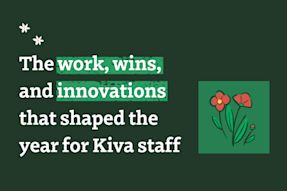As a Kiva lender for more than a decade, Liam thought he pretty much had the organization figured out.
The San Francisco-based software engineer had always admired the simplicity of the platform, how it easily delivers loans that need funding along with stories of the people they would help. With a background in finance and over 900 loans made via computer screen, Liam assumed that the seamless user experience was due to a tight algorithm and a handful of clever coders.
“What I really enjoy about Kiva is how it makes the borrower central to the product. As a lender, I know exactly where my money is going.”
Then he got a peek behind the curtain.
In July 2022, Liam was invited to speak on a panel at Kiva Connect, a meeting that brought together Kiva's employees, including the engineers responsible for making Kiva’s operating system and its services run smoothly.
“When you’ve been on the platform for so long, it seems like, ‘oh, they’ve got this down to a science, there’s probably twenty people keeping the site going,’” he says with a laugh.
“Then I saw so many people in the room, I was like, whoa! This is a big effort with a lot of people doing a lot of hard work.”
Liam’s surprised realization of the platform’s hidden complexities doesn’t reflect his long and storied experience with Kiva and the concept of financial inclusion. He made his first loan in 2012, after he’d graduated from college with a double degree in Economics and Finance and “finally had a little disposable income to contribute.”
His brother introduced him to key readings that piqued his interest in how microfinance could change lives, including The End of Poverty by Jeffrey Sachs and by Dr. Mohammed Yunus’s seminal book, Banker to the Poor.
He also spent time volunteering with the International Justice Mission and the International Rescue Committee, which had confronted him with the reality of inequality as well as how complex charitable donations can become.

“In some of my previous nonprofit experience, I dealt with things like restricted funds, where donors give very generous gifts and want it to go to an exact program or area. That can create a bunch of overhead and end up costing additional money, which makes the gift slightly less effective,” he explains.
“What I really enjoy about Kiva is how it makes the borrower central to the product. As a lender, I know exactly where my money is going.”
The first 27 loans
When he learned the Kiva platform could dial into borrowers in particular countries, Liam knew exactly where he wanted those funds to go. When he was a freshman in college, he and his parents traveled with their church to Uganda, where they met a quiet nine year-old boy in an orphanage in the rural district of Rakai.
“If you’re nine and in an orphanage, the odds of getting adopted are very low. My parents felt that hey, they were in their fifties and getting old, too,” recalls Liam of how his younger brother, Aaron was welcomed into the family.
“The fact that people need access to money, and then actually pay it back—the downside here is very low, in my mind.”
Aaron is now in his early 20s and lives with Liam’s parents in Arizona, and the two trips Liam made to his adopted brother’s home country in 2007 and 2008 made a significant impact on the then-19 year-old.
“Uganda is such a beautiful country, and there's just so much poverty. It was hard to see people living in such a beautiful place, but with such difficult situations,” he remembers.
“You could tell that they're working really hard but they don't have the tools to succeed. There’s no industry, it's street vendors or agriculture.”
Once he had a steady paycheck and joined Kiva as a lender, he began focusing on borrowers who needed a bit of capital to purchase seeds for their farm or stock their retail shops.
“My first twenty-seven loans were all to Uganda,” Liam reports as he scrolls back through his lending history.
“I made the twenty-eighth loan to someone in Kenya, so I didn’t go very far.”
Since then he has made a total of 904 loans in 75 countries, turning his direct investment of US$4,825 into US$22,925 by relending after his loans are paid back. The economically-minded engineer sees it as an investment with incredible impact, considering the default rate on his loans is just three percent.
“Maybe ROI is a weird phrase to use when it’s about people, but it’s also about numbers,” he considers, referring to how his loans have grown.
“The fact that people need access to money, and then actually pay it back—the downside here is very low, in my mind.”
Liam appreciates the accessibility of Kiva not only for borrowers but also for lenders.
“I think it’s about scale—it doesn't have to be a huge thing. A twenty-five dollar loan to me is very small, but it can make a huge difference.”
‘I don’t plan on stopping’
His participation at Kiva Connect may have provided insight into the people behind the platform, but Liam is content to continue lending by following the loans suggested by the software.
“I trust the algorithm,” he says.
“It'll be cool to hit a thousand loans, though I don't really have goals because I just don't plan on stopping,” he promises.
When asked how his sense of responsibility to others might evolve in the future, Liam reveals that he was diagnosed with aggressive B-cell leukemia in 2016, which interrupted his ideas of what might come next in his career or otherwise.
“I think it’s about scale—it doesn't have to be a huge thing. A twenty-five dollar loan to me is very small, but it can make a huge difference.”
“It was the main focus of my life for almost three years,” says the 33 year-old of the long process of chemotherapy and other innovative treatments. “If I had been born twenty years before, I would not have made it.”
He is fully recovered now, except for a deteriorated hip — though that doesn’t prevent him from cycling long distances in the hills across the San Francisco Bay. But the experience with illness, along with his Ugandan brother and the hundreds of borrowers he’s supported on Kiva, remind him no one ever has it all figured out, and that life is precious and short.
“At this point, whatever happens is going to happen,” he reflects.
“I’m just happy to be here.”
Every Kiva lender has a reason for making their first loan. What will be yours?















